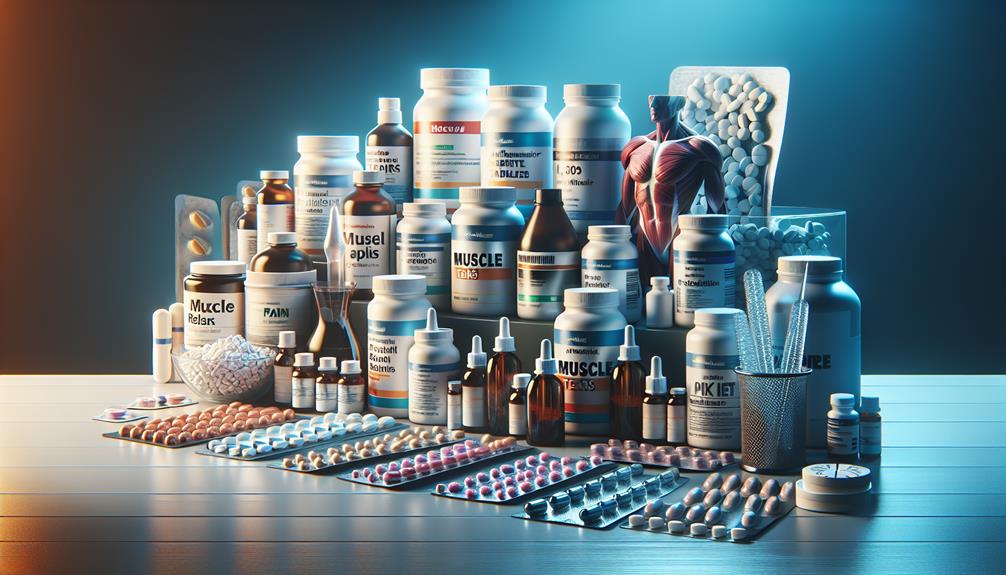If you've ever experienced a muscle tear, you know the pain it can bring. But did you know there are various treatment options available to help you recover and get back to your best self? From rest and ice to more advanced therapies like Platelet-Rich Plasma and surgical interventions, understanding the range of choices can make a significant difference in your healing journey. Stay tuned to learn more about the diverse treatment options for muscle tears and how they can benefit you.
Key Takeaways
- Rest, ice, heat, and therapy aid in muscle tear recovery.
- Medications like NSAIDs and physical therapy help manage pain.
- Advanced options like PRP therapy offer accelerated healing benefits.
- Surgery is a last resort for severe tears, ensuring proper function restoration.
Rest and Ice
To effectively manage a muscle tear, begin by giving yourself ample rest and applying ice to reduce inflammation and pain. Rest is crucial to allow your muscle to heal properly. Ice helps to decrease swelling and alleviate discomfort. After the initial phase, you can consider heat therapy to promote blood flow and relax the muscle. Heat can also help in reducing stiffness and improving flexibility.
In addition to rest and ice, gentle massages can aid in loosening up the muscle and improving circulation to the injured area. Massages can also help in breaking down scar tissue that may form during the healing process. Furthermore, incorporating stretching exercises can prevent the muscle from becoming stiff and improve its range of motion. Strengthening exercises, under the guidance of a healthcare professional, can assist in rebuilding muscle strength and endurance, preventing future injuries.
Physical Therapy
Consider incorporating physical therapy into your muscle tear recovery plan to enhance your healing process and regain strength and flexibility effectively. Physical therapy can play a crucial role in your recovery journey by providing targeted exercises and techniques to help you heal and prevent future injuries. Here's why physical therapy is essential for your muscle tear recovery:
- Personalized Approach: Physical therapists tailor exercises to your specific injury, ensuring a customized treatment plan.
- Guidance and Support: They provide guidance on proper form and technique to prevent further damage.
- Progress Tracking: Regular sessions allow for progress monitoring and adjustments to optimize your recovery.
- Pain Management: Techniques like stretching and strength training can help manage pain and improve mobility.
- Prevent Recurrence: Learning proper stretching techniques and strength training can reduce the risk of future muscle tears.
Medication Options

For managing the pain and inflammation associated with muscle tears, your healthcare provider may recommend specific medication options tailored to your individual needs. Pain management is crucial in the recovery process, and medications can play a significant role in helping you cope with the discomfort while your muscles heal. Nonsteroidal anti-inflammatory drugs (NSAIDs) like ibuprofen or naproxen can help reduce pain and swelling. Acetaminophen may also be suggested for pain relief. These medications are readily available over the counter but should be used according to your healthcare provider's instructions. In some cases, prescription-strength NSAIDs or muscle relaxants might be necessary for more severe muscle tears. It is essential to communicate openly with your healthcare provider about your pain levels and any concerns you have regarding medication. Remember, medication is just one part of the treatment plan, and it is crucial to follow all recommendations for a successful recovery.
Platelet-Rich Plasma Therapy
Platelet-Rich Plasma Therapy can be a beneficial treatment option for muscle tears, utilizing your body's own healing components to promote tissue repair and reduce recovery time. This innovative therapy involves extracting a sample of your blood, processing it to concentrate the platelets, and then injecting the platelet-rich plasma into the injured muscle. Here are some key points to consider about Platelet-Rich Plasma Therapy:
- Offers regenerative potential by delivering a high concentration of growth factors to the injured area, stimulating tissue healing.
- Effectiveness studies have shown promising results in accelerating muscle repair and reducing pain.
- May help avoid the need for more invasive treatments like surgery, providing a less risky alternative.
- Generally well-tolerated with minimal side effects, making it a safe option for many individuals.
- Requires multiple sessions for optimal results, so commitment to the treatment plan is essential for success.
Considering Platelet-Rich Plasma Therapy's regenerative potential and positive outcomes from effectiveness studies, it could be a valuable non-surgical option to aid in your muscle tear recovery.
Surgical Interventions

When dealing with severe muscle tears that do not respond adequately to conservative treatments, surgical interventions may be necessary to facilitate optimal healing and recovery. Surgical repair for muscle tears involves stitching the torn muscle back together to restore its function and strength. The decision to undergo surgery is typically made after a thorough evaluation by a healthcare professional, considering factors such as the extent of the tear and the individual's overall health.
After surgical repair of a muscle tear, the recovery timeline can vary depending on the severity of the injury and the type of surgery performed. Generally, patients can expect a period of immobilization followed by a gradual rehabilitation program to regain strength and flexibility. It is crucial to follow post-operative care instructions provided by your healthcare team to promote proper healing and prevent complications.
While surgical interventions for muscle tears may require a longer recovery time compared to conservative treatments, they can be highly effective in restoring function and reducing the risk of re-injury. It is essential to consult with your healthcare provider to determine the most appropriate treatment plan for your specific situation.
Frequently Asked Questions
Can Muscle Tears Be Prevented in the Future?
To prevent future muscle tears, focus on injury prevention with proper stretching techniques and warm-up routines. Understand muscle tear risks and gradually build intensity in your workouts. Consistency in these practices can help minimize the chances of injury.
Are There Any Specific Dietary Recommendations or Supplements That Can Aid in Muscle Tear Recovery?
You might think just resting is enough, but nutrition support and healing supplements play a vital role in muscle tear recovery. Combine these with tailored exercise recommendations and physical therapy for a speedier, more effective healing process.
How Long Does It Typically Take to Fully Recover From a Muscle Tear?
Recovering from a muscle tear varies based on severity. Rehabilitation methods like physical therapy can enhance recovery. Typically, return to sports ranges from 4-12 weeks. Impact on athletic performance may persist post-recovery, requiring gradual reintroduction to activities.
Are There Any Alternative Therapies or Treatments That Can Help With Muscle Tear Healing?
When dealing with muscle tears, exploring alternative therapies like massage therapy, acupuncture, physical therapy, herbal remedies, and homeopathic treatments can complement traditional approaches. These options aim to enhance healing, reduce pain, and improve recovery outcomes.
Can Muscle Tears Lead to Long-Term Complications or Issues if Not Properly Treated?
If not treated properly, muscle tears can lead to long-term consequences like decreased strength and mobility. Following rehabilitation protocols is crucial to prevent these issues. Take care of your body to avoid potential complications.
Conclusion
So, after learning about the treatment options for muscle tears, you're probably thinking, "Great, just what I needed – more ways to heal!" But hey, remember, taking care of your body is important. Rest up, go to physical therapy, consider medication, or even try platelet-rich plasma therapy. And if all else fails, surgical intervention is always an option. Just remember, it's all about getting back on your feet and back to doing what you love. Stay strong!













